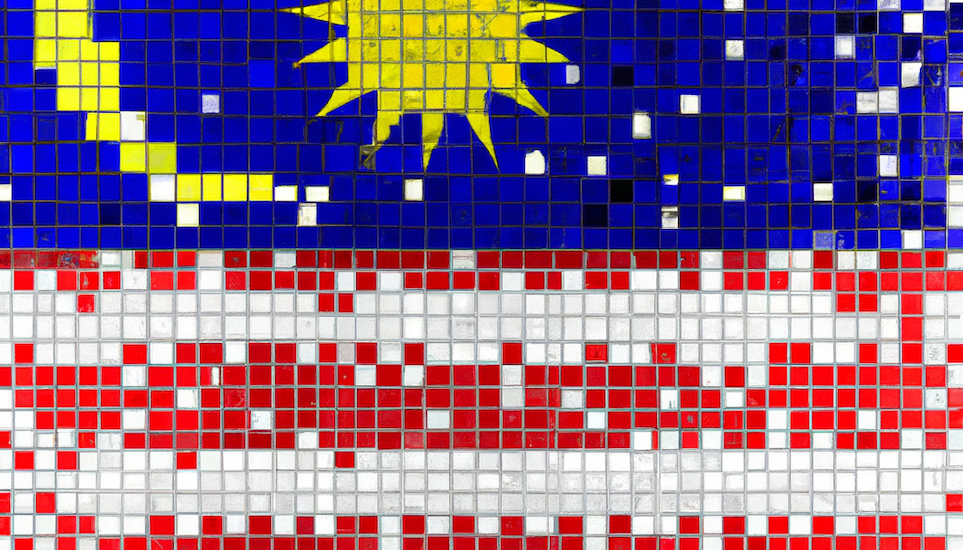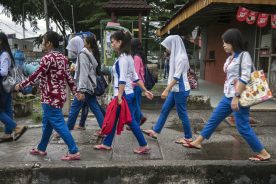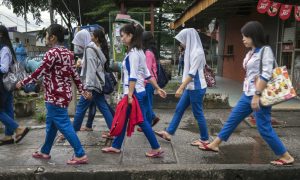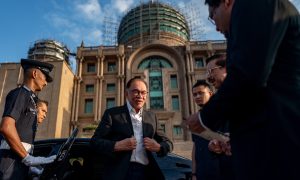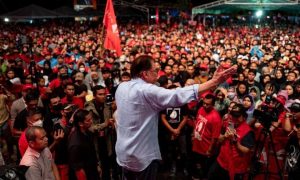Malaysia is always full of hope and despair, all at the same time. Politics, society and culture are entangled along so many lines that it is difficult to see the whole for all its parts. This entanglement of identities, cultural and social communities and expectations has divided families and even brought the country close to outright internal strife.
In a panel at the 2023 Malaysia and Singapore Studies Association of Australia’s symposium held on 7–8 July, we will delve into the complexities of identity and identities that coexist, are subsumed, maligned, ignored and rejected in Malaysia. We know only too well the major debates around Malayness, the role of Islam and the dominant power dynamics between Chinese-Malaysians and Malay-Malaysians. We seek to highlight groups on the margins and their place in a country that has historically erased or deprioritised their needs to live full and dignified lives.
In the early 1960s, the newly independent Federation of Malaya was in discussions with Singapore (then still under British rule) about a Greater Malaysia merger that would nearly equalise the Malay and Chinese populations. The worry in Peninsular Malaya was that this would jeopardise Malay dominance over the new Federation, especially with the threat of communism encroaching on the region. Malaya’s solution was to add North Borneo and Sarawak (Brunei rejected its inclusion) to their Federation and gather all natives under the umbrella term bumiputera, or “sons of the soil”.
This unification plan came with its own caveats, mainly due to geography and cultural differences. North Borneo and Sarawak alone had approximately 70 ethnic groups between them whose indigenous majority were made up of KadazanDusuns and Ibans respectively. In the 1960s, these communities were predominantly Christian or animist Dayaks with cultures rooted in oral traditions. Scepticism from the Borneo Territories was rooted in fears that Malaya’s motivations were expansionist and that they might find themselves being dominated politically and culturally.
These apprehensions were assuaged through a series of formal discussions and were addressed by including constitutional and other safeguards, such as religious freedoms, the preservation of Indigenous cultures, languages, border protections and land rights. In addition, the Indigenous peoples of Borneo would be able to share the same social privileges as the Malays of the Federation of Malaya. A new Federal Constitution for Malaysia would be drafted with conditions set out by the Borneo leaders and intelligentsia documented in various forms, such as the Inter-Governmental Committee, 18 & 20 Point Agreement, the Malaysia Agreement 1963 and the Keningau Oath Stone in 1964—blueprints for their new imagined country.
The terrain of exclusion
The joy and camaraderie of this newfound union in 1963 was short-lived. Many of the safeguards and conditions set out in the founding documents have been violated and the contributions of the Borneo leaders were sidelined to uphold a false narrative that Malaysia, not Malaya, gained its independence from the British through UMNO’s efforts. For nearly half a century, Malaya’s Independence Day on 31st August 1957 was celebrated as Malaysia’s date of birth whereas Malaysia Day (16 September 1963) was only celebrated nationwide starting from 2010.
Peninsular-centric nation building policies have long neglected and suppressed Borneo-Malaysia’s histories, its languages, cultures and economic contributions, a matter requiring urgent redress. In a bid to reverse this, new nation-building culture policies are supporting more work from Borneo artists but discrimination towards East Malaysians in entertainment and media has largely gone unaddressed. Adequately representing the experiences and stories of marginalised people in the arts, media and education is vital to democracy, prosperity and multiethnic relations. Politically, a hopeful sign is in the growing awareness surrounding the Malaysia Agreement 1963, which remains a bedrock of values to imagine a country where hopefully one day Borneans can be the equal partners they were promised to be in Malaysia.
Economic redistribution should start from giving workers bargaining power long denied to them.
A labour agenda for Malaysia
To date, Malaysia has ratified only three treaties: the Convention on the Rights of the Child (CRC), the Convention on the Elimination of All Forms of Discrimination Against Women (CEDAW), and the Convention on the Rights of Persons with Disabilities (CRPD). Domestically, the immense contestation surrounding fundamental rights and their norms remains significant, even after the political change in 2018.
Positive discourse on human rights proves to be challenging and complex in Malaysia due to the lack of human rights practice in various stages of development. Furthermore, Malaysia subscribes to the notion that human rights are subject to cultural relativism. During the early 1990s, when Malaysia achieved economic and social progress, the idea emerged that Asia’s version of human rights should rest on distinctively Asian values. Following the Vienna Conference in 1993, this notion aimed to cast doubt on the normative superiority of Western-style human rights and question the desirability of exporting that model to Asian societies. Some also argue that it is an attempt to impose a form of neo-colonialism and conspire to handicap Asian economies due to financial crises. Although the discussion on Asian values has subsided in Malaysia, the contestation of human rights norms continues.
Backlashes, such as the episode during the anti-ICERD (International Convention on the Elimination of All Forms of Racial Discrimination) protest during the first Pakatan Harapan (PH) government in late 2018, serve as reminders that the pro-rights agenda continues to be challenged and can face reversals. LGBTQ communities have been used as scapegoats, reinforcing that human rights are deemed a Western concept. The state’s understanding of gender and sex remains binary, inaccurate, and laden with morality. The government exhibits resistance to employing evidence- and rights-based frameworks to address human rights violations towards marginalised groups. The contestation of human rights norms becomes challenging as certain narratives resonate with certain segments of society, especially in a context where narrow nationalism is on the rise due to political shifts under the nationalist agenda.
Marginalisation remains a significant cause of social exclusion, where affected individuals or groups face a range of harms. In the case of Malaysia, the government has failed to recognise the correlation between state responsibility and inequality. The lack of legal enforcement and asymmetric power relations perpetuate human rights violations through systemic and structural failures. The recognition of marginalisation and the protection of vulnerable groups are limited by domestic legal frameworks and local social constructions, such as the diversity of cultural practices and ideals. Additionally, negative and discriminatory perceptions of marginalised groups reinforce structures of disadvantage and deprivation, further marginalising them. This situation is partially explained by the lack of respect for the principle of non-discrimination and a historical disregard for cultural diversity and plurality.
Take the example of poor Indian women, who form a sizeable marginalised group as part of the larger Indian community and the socioeconomically disadvantaged “bottom 40%” or “B40” group. Additionally, the 2017 Malaysian Indian Blueprint, an official study of the socioeconomic circumstances of the Indian community, asserted that the B40 Malaysian Indians are significantly underrepresented in most domains required for social mobility (education, employment, health, housing and other aspects). Academic research on Indian women points to a marginalisation that is both caused by structural factors, including national economic policies, as well as the cultural and personal limitations on accessing further education and lifting their prospects for social mobility. The continued power of the dominant patriarchal system, both inside and outside households, “others” women in both the private and public arenas and therefore vulnerable to marginalisation.
Such marginalisation of women needs to be addressed holistically, because it not only affects the Indian community but Malaysians as whole. However, this also shows that Malaysian Indian women carry multiple vulnerabilities that lead to enduring multiple forms of marginalisation, both as women due to their gender and as Indians due to their ethnicity. Gender remains a major issue in patriarchal communities where women are subjected to particular roles and deemed subservient to men. This has maintained an intergenerational poverty trap for poor Indian women that no government program has sufficiently addressed. Marginalisation inherent in the history of how during colonialism many indentured Indian labourers were brought to Malaysia, and subjected to segregated life on plantations for example, has continued in the capitalist driven labour market in Malaysia that continues to require cheap labour. Thus, it remains extremely hard for many marginalised communities and individuals to build up their capabilities such as education, health, time, employment, and savings. Many have inherited a lack of such capabilities from their parents, great-grandparents, and beyond, meaning that the intergenerational marginalisation remains a pressing issue to address.
Worse still is the situation for refugees in Malaysia, who have no legal right to even exist in Malaysia and whose presence is deemed a national security threat. Amid ongoing contestation about identity politics among Malaysians, an “us versus them” mentality is being entrenched in othering foreigners.
The Rohingya, for instance, have been coming to Malaysia since the 1970s due to their statelessness. Numbering around 200,000 in Malaysia, their refugee status is not recognised and thus they are denied any rights to decent livelihoods and education. Despite being Muslims, and many having assimilated into the Malay culture, Malaysia cannot become home for the Rohingya due to structural barriers and societal prejudice. Yet Rohingya are tolerated because they have become ghost labour, who are exploited as cheap workers in sectors that are shunned by Malaysians. The rampant labour exploitation contributes to Malaysia’s poor standing in human trafficking reports. To ensure Rohingya and other refugees who require protection can have dignified lives, the government should grant all refugees the right to work legally and contribute to the nation’s economy. Refugees’ human capital can then be utilised for Malaysia’s development and eventually create a “win-win” situation.
What Malaysia has to gain from inclusion
As we have outlined, a persistent national challenge has been the inclusion and integration of minorities, be they ethnic, political, economic, social or sexual, in the nation and the nation building efforts. Thus, we posit that Malaysia and Malaysians need to continue to ask themselves some uncomfortable questions, and better still, finally answer some of them through a bolder and consistent vision of and for Malaysia. Some of these questions are: What is the place for Orang Asal (Indigenous peoples) and non-Muslims in the nation? When will refugees and migrant workers be allowed a dignified life in Malaysia? Will Malaysia end repressive colonial and religiously based legislation that targets or neglects various groups of minorities?
At 60 years the federation of Malaysia has (yet) another new government, and many commentators are still full of hope—some already dashed, some still alive. The new government headed by Anwar Ibrahim has a new slogan to unite the country and address some of the challenges we have described: Malaysia madani (civil Malaysia). Malaysia has seen many such slogans and nation building projects come and go. There was Mahathir Mohamad’s Wawasan 2020 (vision 2020) to achieve fully industrialised nation status by 2020—now postponed for a later date—the “blank banner” of Islam Hadhari Abdullah Ahmad Badawi) and the ill-fated 1Malaysia of Najib Razak to name a few. Every new prime minister tries to make a mark with such programs and projects, not least to tell a new story about the new administration and its vision for Malaysia.
Malaysia madani incorporates kemampanan (sustainability), kesejahteraan (prosperity/well-being), daya cipta (innovation), hormat (respect), keyakinan (confidence/trust) and Ihsan (compassion). These lofty ideals must be matched by government action, legislation and spending on empowerment programs targeting marginalised peoples in Malaysia, be they marginalised economically, socially, culturally, religiously, or based on their abilities or capacities. Otherwise the lack of effective participation in society, the social exclusion and lack of representation many people feel and are subjected to will continue to define their marginal status in Malaysia.
Against such odds and cognisant of the manifold challenges facing Malaysia (of which we have focussed on just a few), we nonetheless envision a hopeful future where all peoples in Malaysia can live together peacefully and more hopefully even prosper in a form of multiculturalism that acknowledges and includes them—more so, breaks the existing power dynamics and rethinks the place of everyone within the nation moving forward. Ella Shohat and Robert Stam describe such a “polycentric multiculturalism [a]s reciprocal, dialogical. It sees all acts of verbal or cultural exchange as taking place not between essential discrete bounded individuals or cultures but rather between mutually permeable, changing individuals and communities.” And such a form of multiculturalism “thinks and imagines from the margins”—a call we should all heed.
_____
The authors are presenting at the Malaysia and Singapore Society of Australia 2023 Symposium Who are you, Malaysia? Representations of Malaysia’s Past, Present, and Future after 60 Years of Nationhood on “Being ‘Other’: The place of and for marginalised identities and communities in Malaysia’s complex histories, present and futures.” The conference panels will be livestreamed on Facebook here.
 Facebook
Facebook  Twitter
Twitter  Soundcloud
Soundcloud  Youtube
Youtube  Rss
Rss 